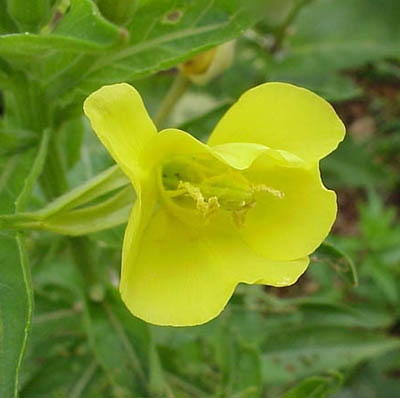| |
|
| |
Evening
primrose (Oenothera biennis)
 |
Evening Primrose Oil has been called the most sensational preventive discovery since vitamin C. It contains the pain relieving compound phenylalanine and is increasingly being used to treat chronic headaches. It is currently being studied all over the world as a treatment for aging problems, alcoholism, acne, heart disease, hyperactivity in children, symptoms of menopause, multiple sclerosis, weight control, obesity, PMS and schizophrenia. It has so many preventive and therapeutic qualities that it has become a standard part of recommendations of many herbalist for maintaining youth and preventing disease.
Evening Primrose Oil contains a high concentration of a fatty acid called GLA and it is this fatty acid that is largely responsible for the remarkable healing properties of the plant. In fact, Evening Primrose contains one of the highest concentrations known of this important substance and only a few other plants contain it at all. This makes Evening Primrose an important medicinal herb, and as studies continue, the list of benefits will likely become much longer. The gamma-linoleic acid, linoleic acid and other nutrients in this oil are essential for cell structure and improve the elasticity of the skin. These fatty acids also help to regulate hormones and improve nerve function aiding problems ranging from PMS to migraine headaches. The hormone balancing effect contributes to healthy breast tissue.
Specifically, evening primrose oil may help to:
Relieve the discomforts of PMS, menopause, menstruation, endometriosis and fibrocystic breasts:
By interfering with the production of inflammatory prostaglandins released during menstruation, the GLA in evening primrose oil can help to lessen menstrual cramps. It may also minimise premenstrual breast tenderness, irritable bowel flare-ups, and carbohydrate cravings, and help to control endometriosis-associated inflammation. Many PMS sufferers are found to have unusually low levels of GLA in their systems, which is why supplements might help so much. In women with fibrocystic breasts, the oil's essential fatty acids can minimise breast inflammation and promote the absorption of iodine, a mineral that can be present in abnormally low levels in women with this condition. In menopause, it is widely reported that Evening Primrose oil reduces hot flushes and increases feelings of well being.
Ease the joint pain and swelling of rheumatoid arthritis:
Supplementation with evening primrose oil and other sources of GLA has been shown to lessen the joint pain and swelling of this crippling disease. A six-month study reported fewer signs of inflammation in rheumatoid arthritis sufferers taking capsules containing GLA than in those taking a placebo. In another trial, the number of tender joints and swollen joints dropped significantly with GLA but not with a placebo.
Prevent diabetes-associated nerve damage:
Research indicates that the GLA in evening primrose oil can help prevent, and in some cases even reverse, the nerve damage (neuropathy) so commonly seen with diabetes. In a year-long study, such symptoms as numbness, tingling, and loss of sensation in participants with mild diabetic neuropathy were less marked in those who took evening primrose oil than in those who took a placebo.
Reduce the symptoms of eczema:
In some cases, eczema develops when the body has problems converting dietary fats into GLA. Getting supplemental GLA from evening primrose oil may therefore be helpful. Some studies indicate that this oil can outperform a placebo in relieving eczema-related inflammation, as well as the itching, oozing, and flaking associated with this condition. By taking GLA, eczema sufferers may tolerate reduced doses of steroid creams and drugs, many of which cause unpleasant side effects.
Help treat acne and rosacea:
By working to dilute sebum, a thick oily substance that is oversecreted in some people with acne, the essential fatty acids in evening primrose oil may reduce the risk of pores becoming clogged and lesions developing. The oil's EFAs help treat rosacea by reducing inflammation, controlling cells' use of nutrients and by producing prostaglandins, which stimulate the contraction of blood vessels.
Disclaimer: The information presented herein is intended for educational
purposes only. These statements have not been evaluated by the FDA and are not
intended to diagnose, cure, treat or prevent disease. Individual results may
vary, and before using any supplements, it is always advisable to consult with
your own health care provider.
|
| |
|


















